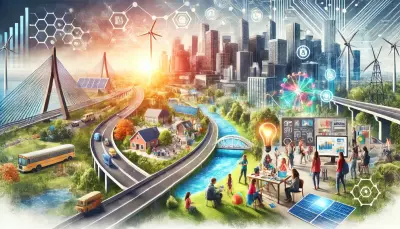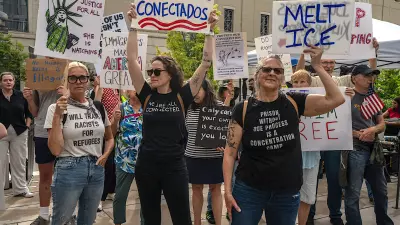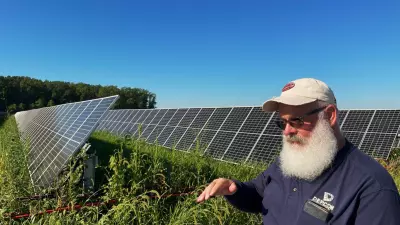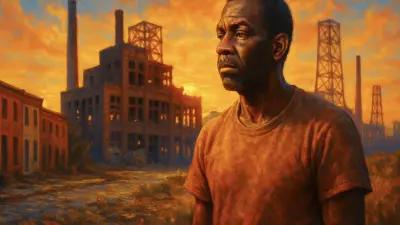Greater investment in people and places that need help adapting to a fast-changing economy will help close the economic divide and bolster the middle class.

Finding new ways to do things has always been our nation’s greatest economic strength.
More than any nation, we have excelled at creating the new, more advanced, or even disruptive game-changing idea, process, product, or new technology (including when it is a service) that changes the economy entirely, creating whole new businesses and new (and often very different) good paying jobs in the process.
Henry Ford did it when he pioneered mass production manufacturing, which was copied around the world. We did it again when we created the Internet. We are doing it again now with automation, machine learning, AI, and biotech.

This ongoing dynamic innovation process that creates new disruptive services, products, and technologies –aren’t the fruit of an industrial policy—if by industrial policy one means either national policy picking and betting on key sectors or bankrolling an old-school manufacturing revival.
David Brooks gets it right in his recent column when he notes that these understandings of industrial policy are not effective. An effective “industrial policy” (which I would rather call “good economic policy”) creates an environment in which the private sector and the market—and money-making entrepreneurs– do their thing, including delivering good-paying jobs and business growth.
Nurturing this environment for private sector-led growth has historically been the United States’ strong suit. We invested as a nation in the economy-building enablers the private sector doesn’t (or can’t) do on its own.
One excellent example is infrastructure. Think of yesterday’s interstate highway system, which powered our national growth in the mid-20th century. The analog today is getting broadband extended everywhere, allowing any individual or business to play and sell in the world.
The United States once led the world in providing great education and, yes, advanced education for the masses. Our creation of the world’s largest network of high-quality, low-cost public and land grant universities during the 1800s (first built in the states of the heartland, the community college system (first created in Joliet, Illinois), and programs like the GI Bill– meant the United States was once the best-educated country and the most prosperous. (Sadly, we’ve scaled back the national and state investments in these institutions that made them high quality and almost free (no more!) —since the “starve the beast” slash government movement began in the 1980’s.)
After World War II, basic and applied search dollars poured from the federal government that – competitively won by our great universities — brought us economic game changers from GPS to the Internet to life-saving drugs.
This is the kind of recipe for a striving America we once animated and that we need to do again, and (interestingly) are finally beginning to move forward with the Biden Administration’s string of domestic legislative achievements.
The current suite of investment packages enacted by President Biden and the U.S. Congress – specifically, the American Rescue Plan Act (ARP), the Infrastructure Investment and Jobs Act (IIJA), the CHIPS and Science Act, and the Inflation Reduction Act (IRA)– collectively worth some $3.8 trillion–represent the largest single place-focused investments in our nation’s history.

And with two exceptions – these investments are sector-agnostic, not picking winners or losers.
It’s only in semiconductors and the huge green energy investments incorporated by the Inflation Reduction Act that the national government is steering the outcome.
Arguably, this is because:
a) With advanced semiconductors made almost exclusively in Taiwan, we had to do something from a national security perspective to guarantee our supply should Communist China gobble up Taiwan
b) We also had to do something to treat the giant globe-wrecking economic externality that was our reliance on greenhouse-spewing fossil fuels. Failing to muster the political will for a much better carbon tax remedy, we put massive production incentives in place.
That’s it! All the other investments in these giant spending plans are for science, research, innovation, infrastructure, worker training – whatever domains of need and excellence we find and uncover.
Look at the two big competitions to win massive federal funding for non-coastal Tech Hubs and Innovation Engines. As I noted for Brookings, the winners – many anchored by leading universities across the Midwest and U.S. heartland – are working on advances in quantum computing, advanced materials, energy storage, bioinformatics, advanced sustainable plastics, and textiles.
This means the winners are working on whatever game-changing innovations are the fruit of the world-class competencies found in our companies and universities– NOT what the government deems as economic “winners”! (And notice these centers of new excellence aren’t talking about ‘manufacturing” alone—making things is a natural by-product of creating some new materials, process, or product.)
So, if there is an element of state direction to this current round of so-called industrial policy, it is better understood as place-focused economic policy—bringing economic enablers to the heartland people and places where they are needed the most.
In his search for what an effective industrial policy might be, Brooks is correct to note that there is also what he calls a non “economic” dimension to this “chasm” between places and people that have lost their economic anchors and those that are thriving. Communities are degraded. People are rightfully upset about their communities’ condition and lament the loss of schools, sports teams, local bars, restaurants, and meeting grounds.
But rebuilding these institutions is yet another path to economic revival for many communities. In an era where mobile talent can live, work, and run a business anywhere they want—communities that invest (with needed help from our governments) in a rich fabric of their community can grow and thrive again.
Some hard-headed economist friends did a great study that we wrote about for Brookings that proves that communities that develop a rich amenity base such as recreation opportunities, cultural activities, and excellent services (e.g., good schools, transportation options) see a bigger payoff in the form of outcomes we really care about, like good-paying jobs and population growth, than communities that animate traditional “business-friendly” measures, such as tax-cutting or weakening regulation. This suggests another important piece of effective “industrial policy” for economic regeneration are the kind of flexible resources for community building, as called for by our proposal for flexibly funding distressed communities (a program included in the CHIPs Act as a pilot program—but worthy of more universal application).
This is the real recipe for America’s rejuvenation:
- Focus investments on the people and places that need support in making a successful transition in a fast-changing economy.
- Fund at scale the economy-building enablers that the private sector doesn’t: infrastructure, innovation, education, higher education, and upskilling (particularly for those workers dislocated by economic change—an arena where America has failed miserably), provide flexible resources for communities to build on their own assets and enrich their quality of life and place.
Then do what we do best— let the entrepreneurial genius of America take over. The economic chasm will close (and manufacturing will take care of itself!).







